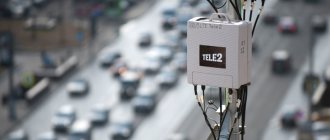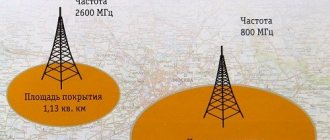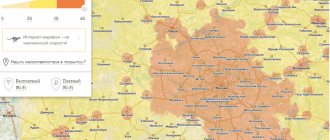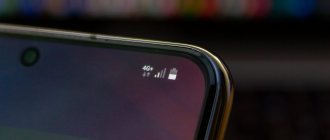The mobile operator Tele2 is developing rapidly and is steadily expanding its coverage area and communication quality. Tele2 cell towers on the map below allow you to verify this; their number is sufficient to provide stable coverage to most regions of our country.
Briefly on the topic
- Tele2 base stations operate on equipment from Nokia Networks and Flexi Multiradio
- The company is currently working towards the development of the 4G communication format
- Stations are located everywhere: rooftops, roadsides, subways and other places
Tele2 cell towers on the map
The mobile operator Tele2 is developing rapidly and is steadily expanding its coverage area and communication quality. Tele2 cell towers on the map below allow you to verify this; their number is sufficient to provide stable coverage to most regions of our country.
- Tele2 base stations operate on equipment from Nokia Networks and Flexi Multiradio
- The company is currently working towards the development of the 4G communication format
- Stations are located everywhere: rooftops, roadsides, subways and other places
Coverage regions
In 2003, a resident of Kaliningrad, who often went on business trips to Ufa, really had to clarify whether his SIM card would receive communication in Bashkortostan or not. The operator had just entered the Russian market and tele2 coverage was very small.
Attention! The computer model of the map is informational; the actual coverage area of the Tele2 network may differ from the simulated data. The differences can be either towards a more confident reception or vice versa.
Factors affecting the quality and reception area of the Tele2 Mobile network:
- Weather conditions: fog, rain, snow.
- The terrain in the reception area is mountains and lowlands.
- The presence of obstacles interfering with the signal propagation, walls, buildings.
- Equipment quality.
Equipment
Our inquisitive readers are probably interested in knowing which towers Tele2 operates on? The telecommunications equipment that this cellular operator uses is truly first-class. Nokia Networks and Flexi Multiradio are the towers Tele2 uses, and these manufacturers produce the latest generation equipment.
Now this mobile operator aims to provide its customers with an uninterrupted signal in 4G format and is successfully working in this direction - residents of large cities have already seen this. In Moscow, St. Petersburg and many other cities, there is an LTE signal even in the metro. To verify this, we recommend reading the article about the Tele2 coverage map in the metro, which is available on our website.
How they work
How does a standard base station work? In a nutshell, your SIM card receives the signal issued by the nearest tower, thereby providing you with various communication services - the ability to make calls, receive and send SMS messages, and mobile data transfer. When a person moves with the phone turned on, the device will invariably receive a signal from the nearest tower, that is, switch between them. This way the connection will always be good. The exception is when something interferes with the signal - for example, you are in a basement where no additional equipment is installed, or you have gone out of town and the nearest station is quite far from you.
These are not Swedes
There is another option! BUT! It may very well be that the neighbors don’t even know that there are better options. And if you would also like the Internet, the situation becomes more complicated, because voice communication is only half the battle and it is far from a fact that the same operator will give you stable Internet at the same time.
- Electromagnetic field level up to 10 mW/cm2 and no more;
- Installed transmitters 1.5 – 5 meters above roof level (depending on the power of the repeater);
- The location of the object is no closer than 10-25 meters from another house;
- Access to the roof and to the towers is isolated for people.
The truth about cell towers
more than 744 thousand have been built in Russia , which allow us to use our gadgets, make calls, download music and surf the Internet.
Each tower has its own owner, one of the Big Three operators. Below I have collected data that will certainly help you make a decision: which operator to connect to in the future.
Not only the quality of coverage, but also the speed of data transfer and mobile Internet depends on the number of towers in the assets of each operator.
According to Roskomnadzor, more than 300 thousand cell stations support the most modern communication format: 4G/LTE/LTE Advanced.
All these stations together provide high-speed Internet to more than 90% of all residents in 83 regions of Russia.
What should a traveler take?
Tinkoff Mobile also has an excellent application, technical support and the most transparent conditions. One of the disadvantages is the intrusiveness of the bank's salespeople, who, after issuing a SIM card, will start calling you with special zeal. Fortunately, they can always be blacklisted. There are cases when the store may refuse this service, but in most cases, the unlocking is carried out on the spot, or when filling out an application, they send the subscriber a service code to remove the restriction on using a smartphone with SIM cards from other operators.
Who owns cell towers
The list of operators by the number of their own towers looks like this:
MegaFon - more than 238 thousand cell stations.
MTS – about 184 thousand cellular stations.
T2 Mobile – 167 thousand cellular stations.
Beeline - more than 156 thousand cell stations.
All four operators own a total of about 80% of all towers. The remaining 20% is owned by third-party organizations, such as Russian Tower and Vertical. These towers are rented to operators for relatively little money, from 15 to 30 thousand rubles per month.
The most advanced operator is MegaFon, which has the most stations, which means the widest network coverage in Russia. Roskomnadzor data also confirms MegaFon's leadership in the number of LTE base stations.
Cell tower close up.
To provide good coverage and high speeds of mobile Internet, operators have to build base stations in a variety of locations.
For example, what MegaFon towers look like in the most remote places:
The towers are installed in the city of Verkhoyansk and the village of Tomtor, in the Republic of Sakha Yakutia, where the temperature drops to -68 degrees.
The cellular station was built 500 meters from the launch field of the Vostochny cosmodrome in the Amur region
The base stations in the Sochi Olympic Park are disguised as palm trees so as not to be conspicuous.
A cell station on the Kola Peninsula is needed for drivers, because there are no cities nearby. Powered by a wind generator.
A cell tower in the rotational village of Sabetta on the Yamal Peninsula, which allows you to post a photo on Insta literally from the ends of the earth.
Network coverage maps were found on the website Speedtest.net. The list of operators is arranged in this order:
1. MegaFon 2. MTS 3. Beeline 4. Tele2
MegaFon has the densest coverage, followed by MTS, which has less dense coverage in the Southern Federal District. Next comes Beeline, and in last place is Tele2.
Russians' struggle with mobile networks
The operator Tele2 has repeatedly faced protests from Russians against its communication towers. For example, on June 22, 2021, residents of the village of Chudinovo (Vladimir region) spoke out sharply against the installation of its tower on the territory of their village. They stated that Tele2 decided not to coordinate the installation of its building with them, and moreover, a team of workers began construction at 4 a.m. literally a few meters from one of the residential buildings.
Chkalovsk is far from the only settlement whose residents are disturbed by operator towers
Three days later, on June 25, 2021, the fierce enemy was seen in the Tele2 tower by those living in the village of Shcherbinino, Stupinsky district (Moscow region). They staged a mass protest, citing the fact that the territory had not been demarcated. The structure was planned to be located less than 100 meters from the nearest residential building, and village residents began preparing an appeal to the prosecutor's office.
Not only Tele2 faces protests from local residents regarding towers, but in a number of cases the authorities take the side of the residents. This happened with the operator MTS - in the spring of 2021, it installed a tower in the center of the private sector in the Ordzhonikidze district of Perm. Residents went to court demanding the demolition of the structure, but initially the decision was made in favor of MTS. After this, the Russians filed a complaint with Roskomnadzor, and this had an effect. In June 2021, MTS received an order to dismantle the installed tower.
VTB Leasing introduces data management as a valuable business asset
IT in banks
However, such disputes in Russia are not always resolved by legal methods - more often citizens use faster and more accessible methods, although not at all legal. For example, in May 2019, a 53-year-old resident of the Sverdlovsk region tried to burn down a cell phone tower, not wanting to be exposed to radiation. The tower was located in the village of Kalya, Sverdlovsk region. A criminal case was initiated against the arsonist under Art. 47 of the Criminal Code of Russia “Deliberate destruction or damage to property”, and she faces imprisonment for up to five years.
Also in May 2021, an elderly man living in the Tver region committed lynching over a cell phone tower. He sawed off the support of a tower, the radiation of which, as it seemed to him, was destroying the harvest of vegetables, berries and fruits on his plot, located nearby. A sawed-off communications tower fell onto the wires of a nearby high-voltage line, leaving nearby settlements without power.
What are the forecasts for the future?
In anticipation of the emergence of new 5G networks with increased capacity, all operators are preparing to modify their base stations.
MegaFon and Beeline actively cooperate with Huawei, the main supplier of 5G equipment around the world.
MTS works with Ericsson, and Tele2 works with Nokia.
Back in 2021, all operators successfully conducted tests related to preparing for the introduction of 5G. Moreover, MegaFon showed the best results: the speed of data reception using the new technology in the networks of this operator reached 35 Gbit .
MTS, together with Ericsson, showed the maximum speed on test equipment in the region of 25 Gbit .
Beeline, despite its partnership with Huawei, reported speeds of more than 1 Gbit/sec .
Considering all the facts, MegaFon will be the first to launch 5G in Russia . This is facilitated by the largest number of base stations and cooperation with Huawei.
The arrival of the next generation cellular network is only a matter of time. The operators are already ready for it.
(
4.37 out of 5, rated: 38)
Connection quality
Frequency range in Tele2 for individual regions and regions of the state:
| Location (province/region) | Tele2 gsm/MHz indicator |
| Belgorodskaya | from 1740 to 1880 |
| Bryansk | 1834, until 1854 |
| Vladimirskaya | 1739.8 to 1757.6 |
| Kursk | from 1773 to 1866.2 |
| Karelia | From 1769.8 to 1864.8 |
| Komi | From 1755 to 1850 |
| Leningradskaya | From 1710 to 1880 |
The maximum transmission speed and frequency of 4g from Tele2 is 2100 MHz. More accurate information can be obtained from the operator’s official website.
The whole truth about Tele2 in Moscow
This is a discount store
Initially, Tele2 is a Swedish discount company, a kind of IKEA in the telecommunications market. Maximum cost reduction (to the point that top managers fly on business trips with low-cost airlines rather than business class) and careful cost optimization (there are approximately half as many employees per subscriber as competitors) allow us to keep prices below the market average. When entering new markets, the operator often resorted to a cellular discounter policy, and in Russia, after Tele2 entered another region, prices from other operators often fell by as much as 20-30%.
These are not Swedes
In 2013, the Swedes Tele2 AB sold the company to structures that resold it to the state-owned Rostelecom. The fact is that over the course of 10 years of work in Russia, Tele2 has not been able to obtain permission to launch 3G and LTE networks - even on existing frequencies (so-called “technological neutrality”). While little was required from mobile communications - calls and SMS - this was not critical, but there were fewer and fewer people willing to be content with the Internet with the eternal letter E on the screen. Ultimately, after the sale, officials allowed “technical neutrality”, and the new owners, represented by Rostelecom, contributed licenses for 3G frequencies originally allocated to Sky Link.
Tele2 does not have GSM frequencies in Moscow
In Moscow, Tele2 will only have 3G networks (in the range of 2100 MHz) and LTE (2600 MHz) - the frequency resource in these ranges is the same as that of MegaFon, MTS and Beeline. The operator also has LTE-800 frequencies, which they promised to use at the start, but after that a number of media outlets, citing informed sources, reported that LTE-800 would not appear immediately. We'll tell you how it turns out in the end. But the operator will not have a GSM network at all. On the one hand, this is good: you simply physically cannot get into the zone where the phone switches to the GSM/EDGE network, depriving you of the opportunity to use the Internet with any comfort. On the other hand, try turning on the “3G Only” mode on your smartphone and taking a walk around the capital. You will immediately discover many places where the device loses the network. This is understandable: GSM base stations operate at a lower frequency and, as a rule, with higher power, due to which the signal penetrates better into buildings and spreads better outside the city. The promised LTE-800 also has good range, but it is far from the efficiency of GSM, and Russia has not yet allowed voice transmission over LTE - it will only work in 3G. Well, owners of dialer phones without 3G support are not allowed to join Tele2.
Tele2 offers mainly package tariffs
Tele2 focuses on package tariff plans with included minutes and SMS. They are called "Black", "Very Black" and "Blackest". Offers are focused in the lower and middle price segments. The maximum subscription fee in the regions does not exceed 400 rubles per month, and the basic package costs less than 100 rubles. There are also tariffs without a monthly fee with per-minute calls, and there are also tariffs for business subscribers.
Tele2 is not the cheapest operator. But honest
Once upon a time, Tele2’s slogan was: “Always cheaper.” Then, from banal dumping in pursuit of low prices, there was a reorientation to the optimal price-quality ratio. Now prices differ slightly from the market average, so Tele2 positions itself as an “honest” operator. Honesty lies, firstly, in transparency of tariffs. That is, you will not find any asterisks, hidden conditions, etc. in their description. Other operators, in general, also long ago realized that no one believes in fairy tales like “EVERYTHING IS FREE*. *- the subscription fee of 100,500 rubles per day is not charged every February 29,” but the positioning has been preserved. Secondly - and this is perhaps more important - Tele2 does not quietly connect various services that later unexpectedly become paid, and also does not practice subscriptions, premium traffic tariffication and other rubbish (only Yota does better with this), therefore there are fewer complaints about mobile fraud from its subscribers than the Big Three. However, Tele2, like everyone else, quite allows itself to raise prices for already connected subscribers.
Tele2 has additional services
Tele2 will not offer you any innovations. You won’t be able to pay for subway fares by phone, or any kind of IP telephony: the operator quite rightly believes that almost none of the subscribers know about these services anyway and don’t understand why they are needed, and of those who know and understand - almost no one uses it. The advantages, at a minimum, are that no one will pester you with advertisements for these things, slipping them in anywhere, right down to balance information. At the same time, however, there is mobile television, determining the location of other subscribers, “Replace the dial tone”, “Who called” and a personal account on the site - in general, everything that may be needed, in addition to calls and the Internet. Prices for services are average market prices.
In 3G and 4G standard
Due to high competition among companies providing cellular telecommunications services to subscribers, Tele2 was unable to obtain frequencies in the 900 or 1800 standards in Moscow. It was necessary to use the new generation 3G and 4G networks (tele 2 lte). As a result, this operator turned out to be unavailable for phones operating only in the GSM standard. Below you will see what frequencies Tele2 tariffs operate on in Moscow (these ranges are also used in other regions of coverage of new generation networks, but are used there primarily for receiving and transmitting data on the Internet, and not for telephony):
- Tele2 UMTS (3G): 1920-1935 (transmission), 2110 - 2125 (reception).
- Tele2 Internet LTE standard 800 (4G): 791-798 (transmission), 832-839 (reception).
- Tele2 lte frequencies in Russia standard 2500 (4G): 2680-2690 (reception), 2560-2570 (transmission).
The Tele2 frequencies in question are relevant for 2021 and may vary depending on the region within the ranges described above. There may be a tendency towards the emergence of new ranges or the expansion of existing ones at the federal or regional level. This may occur in the event of one or more operators leaving the market, which entails the unloading of certain bands, or in the event of a merger of companies providing telecommunications services.











